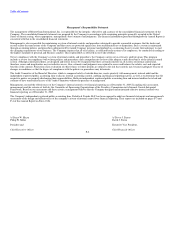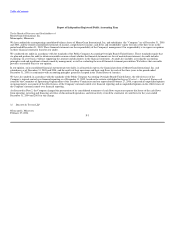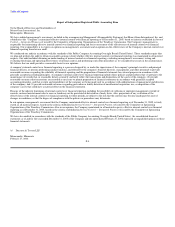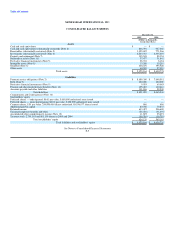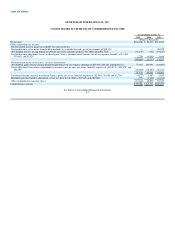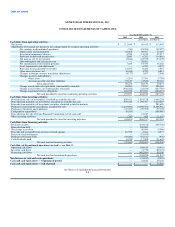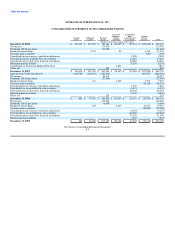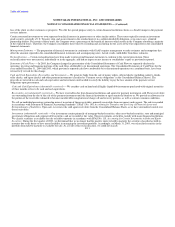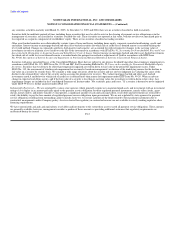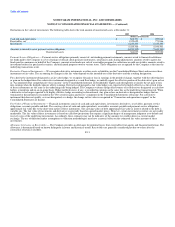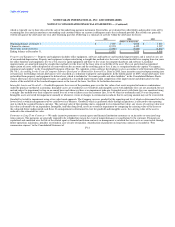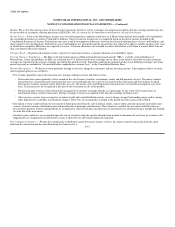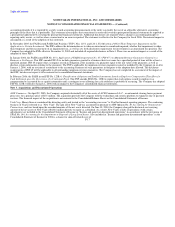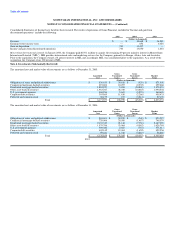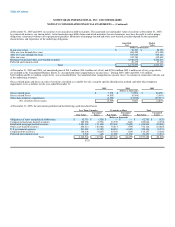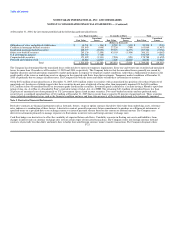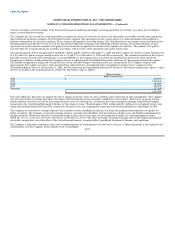MoneyGram 2005 Annual Report Download - page 66
Download and view the complete annual report
Please find page 66 of the 2005 MoneyGram annual report below. You can navigate through the pages in the report by either clicking on the pages listed below, or by using the keyword search tool below to find specific information within the annual report.
Table of Contents
MONEYGRAM INTERNATIONAL, INC. AND SUBSIDIARIES
NOTES TO CONSOLIDATED FINANCIAL STATEMENTS — (Continued)
any securities as held-to-maturity until March 31, 2005. At December 31, 2005 and 2004, there are no securities classified as held-to-maturity.
Securities held for indefinite periods of time, including those securities that may be sold to assist in the clearing of payment service obligations or in the
management of securities, are classified as securities available-for-sale. These securities are reported at fair value, with the net after-tax unrealized gain or
loss reported as a separate component of stockholders' equity. There are no securities classified as trading securities.
Other asset-backed securities are collateralized by various types of loans and leases, including home equity, corporate, manufactured housing, credit card
and airline. Interest income on mortgage-backed and other asset-backed securities for which risk of credit loss is deemed remote is recorded utilizing the
level yield method. Changes in estimated cash flows, both positive and negative, are accounted for with retrospective changes to the carrying value of
investments in order to maintain a level yield over the life of the investment in accordance with SFAS No. 91, Accounting for Nonrefundable Fees and Costs
Associated with Originating or Acquiring Loans and Initial Direct Costs of Leases. Interest income on mortgage-backed and other asset-backed investments
for which risk of credit loss is not deemed remote is recorded under the prospective method as adjustments of yield in accordance with EITF Issue
No. 99-20, Recognition of Interest Income and Impairment on Purchased and Retained Beneficial Interests in Securitized Financial Assets.
Securities with gross unrealized losses at the Consolidated Balance Sheet date are subject to our process for identifying other-than-temporary impairments in
accordance with SFAS No. 115, EITF Issue No. 99-20 and SEC Staff Accounting Bulletin No. 59, Views on Accounting for Noncurrent Marketable Equity
Securities. Securities that we deem to be other-than-temporarily impaired are written down to fair value in the period the impairment occurs. Under
SFAS No. 115, the assessment of whether such impairment has occurred is based on management's evaluation of the underlying reasons for the decline in
fair value on a security by security basis. We consider a wide range of factors about the security and use our best judgment in evaluating the cause of the
decline in the estimated fair value of the security and in assessing the prospects for recovery. We evaluate mortgage-backed and other asset-backed
investments rated A and below for which risk of credit loss is deemed more than remote for impairment under EITF Issue No. 99-20. When an adverse
change in expected cash flows occurs, and if the fair value of a security is less than its carrying value, the investment is written down to fair value. Any
impairment charges are included in the Consolidated Statement of Income under "Net securities gains and losses." If a security is deemed to not be impaired
under EITF 99-20, it is further analyzed under SFAS 115.
Substantially Restricted — We are regulated by various state agencies which generally require us to maintain liquid assets and investments with an investment
rating of A or higher in an amount generally equal to the payment service obligation for those regulated payment instruments, namely teller checks, agent
checks, money orders, and money transfers. Consequently, a significant amount of cash and cash equivalents, receivables and investments are restricted to
satisfy the liability to pay the face amount of regulated payment service obligations upon presentment. We are not regulated by state agencies for payment
service obligations resulting from outstanding cashier's checks; however, we restrict a portion of the funds related to these payment instruments due to
contractual arrangements and/or Company policy. Assets restricted for regulatory or contractual reasons are not available to satisfy working capital or other
financing requirements.
We have unrestricted cash and cash equivalents, receivables and investments to the extent those assets exceed all payment service obligations. These amounts
are generally available; however, management considers a portion of these amounts as providing additional assurance that regulatory requirements are
maintained during the normal F-12


